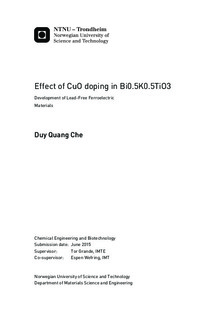Effect of CuO doping in Bi0.5K0.5TiO3 - Development of Lead-Free Ferroelectric Materials
Master thesis
Permanent lenke
http://hdl.handle.net/11250/2377305Utgivelsesdato
2015Metadata
Vis full innførselSamlinger
Sammendrag
Piezoelectric materials are currently used in a significant number of electronic applications, and lead-free piezoelectric materials have obtained much attention in the recent years. Bismuth potassium titanate (BKT) is a lead-free piezoelectric alternative which has been studied with promising results. However, dense and phase pure BKT has proven to be challenging to prepare by the conventional solid state synthesis. This problem is often accredited to the volatility of A-site cations during high temperature sintering.
In this study, BKT ceramics with 0.0 - 2.0 mol% of excess A cations, and 0.3 - 0.9 mol% of CuO addition (BKTC-x, x=0.3-0.9), have been prepared by the conventional solid state synthesis. The materials were investigated with respect to A to B stoichiometry, phase purity, density, dielectric and piezoelectric properties.
The nominal stoichiometric BKT is found to contain B-rich secondary phases. The material proves to be A cation deficient, as these secondary phases are removed by adding 2 mol\% of excess A cations. The densities of these ceramics are measured to be about 92 % of theoretical density. The addition of CuO as a sintering aid was observed to be effective, as the relative density of CuO doped ceramics are determined to be above 95 %. The tetragonal perovskite structure are obtained for all investigated materials, where the lattice parameters slightly increase with increasing dopant level. The dielectic measurements confirms relaxor-like behavior for all compositions, as a broadening of the relative permittivity maximums are observed at the ferroelectric to paraelectric phase transition. In addition, the corresponding temperatures of the relative permittivity maximums decrease with decreasing frequency. The relative permittivity of the CuO doped materials are also found to be larger than the undoped BKT material. BKTC-0.9 provides the most open polarization-electric field hysteresis curve, as well as the largest maximum polarization of 8.5 mu/cm2 indicating depinning of the domain walls. It was observed that the B-rich secondary phases gradually redeveloped with increasing CuO-addition. The result of these investigations suggest that copper ions compensate A cation vacancies on A-site as well as substituting with titanium on B-sites.
